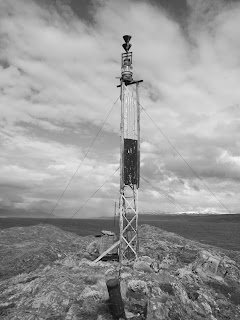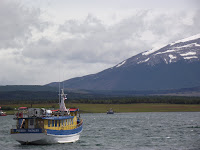With our fine friends from the Beaver state - Oregon, USA, we rented a car and set out on a 100km drive down the coast from Ushuaia to Estancia Harberton. This farm was established in 1886, when the British missionary pioneer Thomas Bridges (1842-1898) resigned from the Anglican mission at Ushuaia, and was given 20,000 hectares of farm land at the very tip of Tiarra Del Fuego.
The estancia was named after Harberton, Devon, the home of Thomas wife, Mary Ann Varder (1842-1922). Bridges was the author of a dictionary of the Yamana or Yaghan language, and their son Lucas Bridges (1874-1949) wrote 'The Uttermost Part of the Earth'' about his boyhood, the Yamana, and the family's adventures in getting the dictionary published in Europe.
Tommy Goodall (born 1933), is Thomas Bridges’s great-grandson, who still manages the estancia with his wife, American biologist Rae Natalie Prosser, with help from their daughter and her children. We we're taken on a tour of the estate by his grandson, also called Thomas (there is one in every generation), and it was a wonderful trip down memory lane, this place could have been a seaside house in Cornwall.
In fact the house itself was shipped as a wedding gift from Mary Ann Varder's family and was declared a national monument in 1999. They have a cute English tea room and little brick outbuildings, and an amazing garden planted with fruit trees and lupins. The huge sperm whale jaw used to create an arch over the garden gate is a reminder to the location of this outpost and the delicate wildlife both on the land and in the sea.
One of the surprise highlights of the trip, was a visit to the Museo Acatushún de Aves y Mamíferos Marinos Australes (Dolphin and Seabirds museum) just 500m from the main house. It is a working Museum/laboratory for the study of the basic biology of the marine mammals (mainly dolphins) and birds of the southern tip of South America. The result of over 34 years of scientific research by its founder, Natalie Goodall, the wife of Tommy Goodhall, the collection contains the skeletons of over 2700 marine mammals and 2300 birds.
All the skeletons have have come from animals found washed up and dead on the shores of Tiarra Del Fuego and Antarctica.
They are painstakingly stripped on their flesh in the 'BoneHouse', a brutally deathly house of bubbling blubber and bones. They are then catalogued and prepared by researchers from all over the world, who come here to intern and work with Natalie. They are sponsored by some big local oil players - Mobile and Total, but receive most of their income from donations. We spent an enlightening hour being show these amazing mammals by a super knowledgeable intern from Mar Del Plata. Check out the pics of the seals, they have four limbs just like humans, you wouldn't think the floppy tail of a seal contained two limbs!
























































 Our first proper camping and trekking expedition down here in Patagonia took us to the wonderful town of El Chalten and the nearby Los Glaciares National Park.
Our first proper camping and trekking expedition down here in Patagonia took us to the wonderful town of El Chalten and the nearby Los Glaciares National Park.